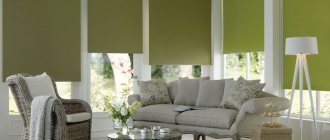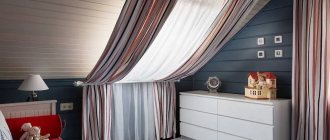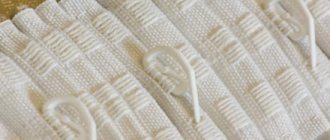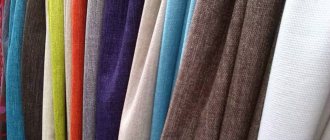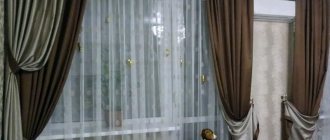Once the renovation is complete, they usually move on to one of the most interesting tasks - decorating the window. Interior textile departments are replete with offers, but before purchasing, it is important to have at least a general idea of how much fabric is needed for curtains. Many people prefer to go to a salon or atelier, but tailoring will cost more than the material. The style is sometimes imposed according to their own standards, and not according to the client’s request. For those who have sewing experience, it will be much more economical to do it yourself.
Textile window decoration is a difficult issue.
Where to start calculating when choosing window design with curtains
For those who have never made window decor, it seems that nothing is easier than taking measurements for curtains. The height to the cornice plus the width of the window - and all the measurements. In reality, everything is much more complicated; many factors have to be taken into account.
- Panel assembly coefficient (depending on the cut and style).
- The width of the roll minus the edges of the curtain fabric.
- Hem allowances.
- Allowance for free sagging.
- Allowances for the fastening method.
- The direction of the ornament or texture of the material.
- Removing the baguette beyond the brackets.
- Additional cost for matching two curtains with a large pattern.
It is important to calculate the amount of material for cutting to avoid unpleasant surprises.
All calculations begin with the style of window decoration - there is no point in saving on the width of curtain fabric and the beauty of freely falling folds. It is also recommended to focus on the roll format and its relationship with the borders of the curtains. In most cases, a curtain covering the entire wall looks much better.
The location of the battery in the window sill niche is also taken into account. The choice of style and length often depends on their aesthetics and dimensions:
- Short curtains in combination with long drapes;
- Curtain to window sill;
- Long curtain;
- Multi-layer window decor with a complex cut.
The choice of curtain style will depend on the size and shape of the window, furniture and interior design in the room.
Only after really assessing the format of the window space covered by curtains can you begin to measure and sew the product yourself. Designers also recommend taking a small supply, at least half a meter. There may be defects inside the roll or errors in calculations.
The remainder can always be placed on sofa cushions, which will organically complement the interior.
We take measurements
Naturally, the process of determining the optimal curtain sizes begins with taking the necessary measurements. So, the main data that we need to obtain is the width and length of the future curtains, and all other data, type of assembly, etc., are then calculated based on these data.
It is worth noting that measurements should be taken after the cornice has been selected and installed . Cornices come in different varieties and can be attached to the wall or ceiling, but in any case, the length of the cornice must exceed the width of the window. If this is a bedroom or other recreation room, then you can attach the cornice to the entire width of the walls, effectively emphasizing the window area. In other rooms, the cornice should be 20-30 cm larger than the window opening so that the curtains can move, making way for the sun's rays, the exception is the kitchen, where, as a rule, only a translucent curtain hangs, and the length of the cornice is almost the same as the width of the window . Please note that now there are curtain rods with adjustable length : if desired and necessary, they can be made a little shorter or longer.
It is advisable, of course, before taking measurements , to already decide on the model of curtains , since the calculation of the length and width of the required fabric will depend on the type of fabric, fastening, and number of layers of window decoration.
- The width of the curtains can be measured with a tape measure or soft measuring tape from the first fastening to the last .
- The length of the curtains is measured from the curtain rod or from the selected fastening elements, for example, rings, to the mark you need.
Curtain style and fabric consumption
The very name “curtain” (from the French store) means “window fabric drapery”. Each era had its own style in fashion, which is confirmed by the artists’ paintings. Initially, the window was covered with fabric (skins, fur) to insulate and regulate the flow of light into the room. Over time, certain types emerged:
- Roman;
- Austrian;
- English;
- French;
- Italian.
It is worth clarifying that not all of them are directly related to the country of origin. Rather, it is a conditional design classification. Each variety requires its own type of cornice and assembly factor.
It is the style and the corresponding pattern that determines or emphasizes the style in interior design.
When calculating fabric for curtains, it is important to consider that there are:
- multi-layer and single options;
- trimmed with contrasting fabric on top or bottom;
- into the assembly with a certain step (marquise) and into the drawstring on the tape;
- with curly coattails, ruffles, frills,
- with tiebacks and lambrequin;
- with fringe, tassels and other accessories;
- completely smooth - Japanese screened curtains, etc.
There is no single cutting formula, because each model is unique.
Some salons sew from their own material, others offer only tailoring. The estimated expense and cost of the work can be discussed with a specialist by phone or by filling out an online form where all the parameters are entered.
How should curtains hang?
The overall perception of the room depends on the height of the curtains from the floor. To make the curtains look harmonious, when choosing them you need to consider:
- if the room is too small, it is better to choose short models, which may be slightly below the level of the window sill;
- long floor-length curtains look good only in spacious rooms;
- Short curtains are most often suitable for the kitchen;
- The classic option is a length of 5-6 cm above the floor, which is suitable for most interiors.
Models with a functional and practical design will maintain a cozy and warm atmosphere in the living room.
What is needed for accurate measurements
When taking measurements, many people make standard errors. It is important to eliminate errors, and the panel should cover the baseboard or even touch the floor covering with its edge.
The fabric is calculated for each individual element, and then everything is summed up and the footage is obtained, which will be correct for a particular option.
Even in panel houses, walls sometimes have curvature and height deviations in the corners. To do this, you need accurate measurements on both sides of the wall on which the cornice is. The difference usually does not exceed 1 cm, but there are deviations of up to 5 cm, although this cannot be determined visually.
Tip: To determine the average length of the curtain, hang a weight on a rope (plumb line) from the extreme point of the cornice. First on one side, then on the other, assessing the difference along the control line of the intended curtain. We derive the arithmetic average (add both measurements and divide in half).
It is always recommended to take into account the composition of textiles and carefully read the label, since natural components shrink by at least 10%.
Batteries, balcony doors, and some decorative elements in interior design make it difficult to take accurate measurements. A plumb line is the best way to accurately determine the correct size of a product.
Another important point is what the measurements are used with. You can use:
- an ordinary school ruler, if nothing else is at hand;
- a measuring tape (colloquially “centimeter”);
- measuring tape.
A tape measure is preferred because it has the greatest length and does not twist or bend like a tape. With it, you do not need to summarize several measurements into a total footage, as with the use of rulers.
Light textiles drape in waves, while denser materials form clear folds, which should not be too many.
Important! Curvature or difference in height of the walls can be detected after sewing the curtains. Removing and altering them, leveling 1-2 cm, will be very difficult. It will take a lot of time and effort. It is much easier to interrupt the cornice by slightly moving one edge higher or lower.
Errors in width are also possible. It is easier to eliminate them by using a universal construction level with laser markings. Along the intended line, mark with a pencil and measure with a ruler the minimum width, to which allowances are added, a small margin in width for the removal of the baguette rod, for lush folds, etc.
The width of the selected fabric and the placement of the picture on the canvas play a primary role in calculating fabric consumption.
You will need a notepad for notes - it is easy to lose the sheet. Be sure to mark, for example, “measurements for the bedroom window” or “curtains for the living room” so as not to be confused. You should not calculate in your head and keep the parameters in your head, especially when you have to put off work for a while.
If you have to calculate the flow rate taking into account various coefficients, a calculator will come in handy. At the same time, it is easier to calculate the approximate cost of window decoration - cornice plus fabric, threads and fittings.
When the pattern is directed along the roll, its maximum width coincides with the maximum width of the finished curtain.
Calculating the length of fabric with a pattern
The main determining element in cutting patterned textiles is the size of the repeat, which is sometimes indicated in the markings. For each curtain panel, a reserve of one repeat is taken, as well as an allowance for combining the pattern, which is calculated by the distance between identical points of adjacent motifs.
Curtains will look much more attractive if the bottom edge ends with the whole pattern rather than part of it.
How to correctly calculate the width: what is taken into account in the consumption of material for curtains
Before you independently calculate the width of the curtains, check whether complex double or triple curtains are needed.
- If you want to hide the unsightly landscape of an industrial area outside a high-rise window, a single curtain made of thick fabric is enough.
- The first floor or curious views from the windows of the house on the other side - if necessary, curtains should be easy to move along the eaves; complex folds are impractical.
- When the main functionality is window decoration in interior design, it is better to choose stationary multi-layer curtains with beautiful folds and overlays; light should easily penetrate through the transparent curtain.
- Night curtains are needed for shift workers, when during the day they have to fully rest in a darkened room.
If you are planning two curtains, then you should divide the length of the cornice by 2. Keep in mind that in some cases you may need an allowance for overlap in the central part of the cornice.
Attention! Most window veils are produced with a roll width ranging from 2.8 to 3.2 m. In this case, dense curtain fabric is often located from top to bottom.
The curtain can be wide and narrow - there should usually be two of them, the standard is:
- 1.4m;
- 2.8m;
- 3.0m.
Complex styles often involve different lengths of tulle, curtains and overlays.
In this case, the footage for each material is calculated separately, taking into account allowances for seams and edge processing. But the basis for calculating the width remains the assembly coefficient.
Calculating the width of the curtain
When purchasing rolled tulle, the width of which is usually 280 cm, we multiply the width of the cornice by the fold coefficient recommended for this type of material. For tulle it is 2 - 3 meters so that the curtain hangs beautifully on the window.
As for curtains, when cutting it is important to take into account the pattern, texture, play in the folds and the plasticity of the material. The coefficient for folds should be 1.5 - 2.5 meters. Roller curtains usually come in three typical sizes - 1.4, 2.8 and 3 meters.
Edge to Edge Pattern
The calculation of the material is carried out in the same way as for tulle, with the condition that the pattern is located from edge to edge.
If the pattern is directed along the edge, then you need to think about combining it on different curtain panels. Calculation formula: product height + number of canvases + pattern report + hem allowances for the bottom.
Drawing along the edge
Pleated curtains and gather factor: what is it?
Before you start calculating curtains for a window, it is useful to look at various styles in catalogs and illustrations. In most cases, the curtain is not just stretched along the cornice, but gathered with soft folds, which gives it special charm and luxury.
When buying window textiles, be sure to consider the cost of processing the edges.
Attention! For lush gathers, curtain tulle is collected not in length, but in width - the roll is unwound along the ceiling, repeatedly making soft folds or gathering on a special tape.
Some types of curtains require a special type of fastening. A regular baguette with rings for hinges is nailed approximately 5-12 cm above the window opening. The higher it is, the better it looks. Today, ceiling models of various formats are most relevant.
- Direct.
- Corner (for two windows in a corner room).
- Round shape (for bay windows).
The approximate amount of fabric largely depends not only on the width of the roll, but also on the style, where the type of cornice plays an important role.
Many have seen curtains on rings - metal eyelets are placed directly on a round rod, the design gives soft folds at equal intervals. Accordingly, these coattails require additional footage.
Good to know! Each style and type of fastening to the cornice has its own assembly factor calculated:
- flat fabric loops - multiply the width of the cornice by 1.5-2;
- curtains on a special tape for uniform assembly - multiply by 2;
- curtains with eyelets – coefficient 2;
- dense fine collection - 2-2.5;
- buffs – coefficient 2.5;
- assemblies with sagging “awnings” – 3;
- bow folds (triple folds) – 2-3, depending on frequency.
Eyelets in the form of metal or plastic rings emphasize the beauty of the cornice, which is important for modern styles.
To correctly calculate the footage, it is important to take basic measurements, taking into account all reserves and errors, multiply by KS - the curtain assembly factor. It would be wrong to take some material at a discount from the remainder of the roll, and then decide which style to choose. Then the choice will be limited, but saving makes sense when sewing small curtains for the kitchen or loggia.
The eyelets glide easily, forming even folds with controlled pitch.
Length options
The visual perception of curtains depends mainly on their length; it serves as the most important parameter of the product. The choice of length depends on its appropriateness in a particular case: on the parameters and functional purpose of the room, on the style and lighting.
When there is enough space Source sdelaipotolok.com
Interestingly, there are no standards defining how long curtains should be. To a greater extent, the parameter is determined by the personal taste of the owners, and to a lesser extent by design. There are the following options for how long the window decor will be:
- Length to window sill. It is often chosen in cases where the window sill is used functionally (a convenient surface for fresh flowers). For such models, light, light-transmitting fabrics are chosen, and the length is set so that there is a centimeter and a half left between the panels and the window sill. If you think that the solution is too laconic, add decor - tulle that matches the style, holders.
Short version with eyelets Source i2.wp.com
- Below the windowsill. A window opening closed with a margin of 10-15 cm looks more elegant. A similar decor is suitable for a dining area decorated in a modern style. The option is also acceptable on the kitchen window, but only if the gas stove is far enough away.
Accent curtains Source oz90.ru
- Above the floor. The lower edge of the fabric ends 5-7 cm above the floor. A traditional option, quite acceptable in small-sized housing with ceilings not exceeding 2.4-2.5 m. Curtains do not accumulate dust and do not make wet cleaning difficult. When deciding what the length of the curtains should be from the floor, do not miss the following nuance. If the window is wide and the curtain pattern is replete with folds, the ceiling will visually appear lower. Such a collapse of space is in many cases undesirable.
Beige curtains of two types Source i.pinimg.com
- To the floor The distance to the floor does not exceed one to one and a half centimeters. The classic size, which, however, is not so easy to measure. It is necessary to take measurements for such decor especially carefully. Carelessness in measurements combined with an uneven floor will lead to an overlap at one edge or, conversely, a gap above the floor.
In a country house Source st.hzcdn.com
- On the floor. A solution suitable for living rooms with high ceilings and certain styles. It looks impressive if the length of the curtains reaches 3-4 m, of which 10-30 cm form a picturesque decor on the floor. An unsuitable option for cleaning fans: dust happily accumulates under the lying fabric, it has to be washed more often and it deteriorates faster. Problems are possible if there are small children and animals in the house. Every now and then you will have to correct and arrange beautiful folds; the structure may collapse if you step on the fabric carelessly.
In an elegant living room Source mydecorative.com
Linen curtains Source www.perdemodelleri.org
See also: Catalog of companies that specialize in installing windows and doors
How to correctly calculate the length of a curtain for a window: important recommendations and examples
The most accurate flow parameters will be obtained if you have a suitable cornice fixed above the window - all measurements are taken with a tape measure from its edge. At a minimum, the ends of the baguette should protrude 15-20 cm beyond the window opening. This is enough to open the curtains after the night and provide more daylight.
The length of the curtains is chosen not only for economic reasons, but also purely practically.
We can talk a lot about how to calculate the fabric for curtains, but a large length is not needed for the kitchen or children's room. In the living room or bedroom, long tulle is traditionally chosen, which can even lie on the floor.
It is better to leave a distance of 1 cm from the floor level to avoid rapid wear.
There is a general length standard:
- curtain to the window sill (the lower edge should not touch it);
- the edge below the window sill, to the level of the heating radiator, if this is a new aesthetic model with painting or a decorative panel;
- the fabric reaches the baseboard or just above the floor, can be easily curtained and does not get dirty if pulled frequently;
- complex romantic cut with tiebacks and draperies, the edges lie softly on the carpet or varnish polymer (perfect order is required, the fabric is prudently lifted onto the windowsill during cleaning).
Curtains will look much more attractive if the bottom edge ends with the whole pattern rather than part of it.
Helpful advice! For floor-length curtains, choose practical materials that are easy to wash and do not require ironing.
When you want to somehow update your window decoration with original decor with draperies, overlays or a lambrequin, it is important to take into account the KS. It is calculated additionally, but the shape of the pattern is taken as a basis. For asymmetrical models, they rely on the longest length of the pattern shape.
Selecting curtain sizes for different rooms
Up to this point, we have talked about the sizes of curtains, taking into account the classic window design options - long in the living room and bedroom, short in the kitchen, on the balcony and loggia. Classic is good and practical in spacious rooms. The smaller the area of the room, the more depressing and heavy the curtains and lush folds of tulle look on the windows. Therefore, when choosing the size of curtains, they are primarily guided by the overall impression of the future design. Then the material and color, the type of cornice and its fasteners are selected. Designers give some practical advice on how to choose the size of curtains for a window in a room for a specific purpose.
Recommendations for decorating windows in the kitchen
Everything in this room should be as practical as possible, even if the apartment is inhabited by a small number of people and the kitchen is rarely used. The size and type of curtain hanging is selected based on the following criteria:
- minimum area of settling of burning, fat and soot;
- the fewer folds, the smaller the area where dirt accumulates;
- curtain height - closed window sill;
- tulle may be missing;
- double curtain with fasteners to ensure ventilation.
The size of the canvas is calculated using minimum coefficients and allowances.
Tips for choosing the size of curtains for a child's room
A child's bedroom is usually small in size. Therefore, massive curtains will not work. When calculating the size of the panel, consider:
- minimum coefficient for fold type;
- increased distance from the floor so that nothing prevents the child from adjusting the position of the valves independently;
- advantages of short curtains - the heating radiator is exposed, the bottom edge is less dirty, easier to adjust, etc.
- The most convenient type of folds to adjust are loops and eyelets.
How to choose the right size of curtains for the bedroom?
Even a small bedroom can be decorated with curtains with massive folds and tulle. The length of the decor can fall to the floor in flowing coattails. This design will give the room a special charm and create a feeling of security. Massive curtains will absorb noise coming from the street. It is possible to combine curtains of different sizes. For example, Roman blinds and drapes. Decorating windows in the bedroom requires careful selection of decor colors rather than size.
Selecting the size of curtains for the living room
The most difficult thing is to choose the length of the curtains for the living room and their decorative effect. Size is very important here, because the first thing a guest sees when entering a room is the window. The decor should be in perfect harmony with the interior design. It’s hard not to stand out and not look good. Therefore, in 9 out of 10 cases they choose the classic design option:
- distance from the floor to the bottom edge of the canvas - 1-1.2 cm;
- average number of folds - light should easily penetrate into the room;
- the presence of light tulle, organza, etc.;
- double curtain.
In the living room it is better not to use a combination of decor types. Moderation and originality are recommended.
Now, having understood the nuances, you can buy ready-made curtains without any problems or sew them yourself.
How to calculate the width of curtains: recommendations from experts
You can come up with any style with unimaginable decor, but everything is determined by the width of the fabric roll. Often, markings are printed at the edge of the roll, and small flaws and creases are possible. It is necessary to inspect the cut when purchasing - the buyer has the right to refuse a piece with defects even if the receipt is punched.
The fabric has edges that are cut off when sewing curtains - they pull the edge and interfere with soft draperies.
Important! To eliminate errors, before making calculations, we mentally unfold the roll from floor to ceiling or along the baguette rod, taking into account multiple folds.
When calculating using any formula, all conditions must be met, for example, the height of the curtains should not exceed the roll format (minus the edge). Their measurements are multiplied by the assembly factor and adjusted to the length of the cornice. This is the basis of calculations if the direction of the roll is along the cornice.
Some people prefer to leave a small strip of material above the mounting tape in the form of a scallop or edge, which gives a beautiful fold and successfully covers the cornice.
If the height of a curtain is calculated - from the floor to the baguette, accurate calculations from the edge of the round rod to the floor itself are important, the style (curtain length and method of fastening) is taken into account, as well as adjustments for hemming.
In some cases, the roll is not enough in width or length. Then several panels of the same material are carefully sewn together, hiding the seams in soft folds and draperies. The consumption is multiplied by the number of pieces of fabric. If the curtains and drapes have a pattern, it must match exactly - this is an additional expense. There is also a standard gathering factor for different types of fabric:
- thin veil and curtain with a small pattern - KS 2;
- curtain fabric – KS 1.7;
- organza without pattern for awning assembly – KS 3.
When using mounting tape, as the most budget-friendly and popular design option, take two widths of curtain tape.
conclusions
Beautiful design of any room is a harmonious combination of basic elements and additional accessories. Selecting the length of the curtains plays a big role in the design of the room. The importance of this interior element cannot be underestimated. In addition to the direct function of protecting the room from sunlight or darkening during sleep, curtains make up from 1/7 to ¼ of the wall area. Bright, dark curtains will suit the interior in an original style.
Calm tones of materials add elegance and restraint to the room. Plain fabrics help to visually lengthen the height. Patterns on the material will add uniqueness to the overall appearance of the room.
How to calculate the length of curtains
How to shorten curtains
Practical calculation examples
- The meter across the width of the canvas is the length of the cornice multiplied by the KS (assembly coefficient).
- The meter in height is the height from the cornice to the floor (another length) plus the margin for the hem (the bottom is separate, the top depends on the method of fastening), we add an adjustment to match the pattern.
- Fabrics with a large pattern, periodically repeated along the roll, are positioned so that it is entirely visible at the top or bottom of the curtain, depending on the design. When calculating, we sum up the length of the pattern repeat plus the additional cost for the full height.
- Sometimes the material puffs up when folds are formed, add another 3-5 cm for free sagging.
For tulle, the fold factor is 2 - 3 meters so that the curtain hangs beautifully on the window.
An example of calculations for a standard window, with a 2-meter cornice at a height of 2.6 m, if the fastening is on an assembly tape, tulle without a pattern:
- width: 2m x 2 (KS) = 4 m;
- length: 2.6 m + 0.15 m + 0.1 m = 2.85 m;
- patterned curtains with a repeat of 0.5 m, we count 2.6 m + 0.15 m + 0.1 m + 0.5 m = 3.35 m.
Attention! To the resulting length we add a margin for hem (the top is larger, depends on the type of fastening, the bottom is enough 2 cm.)
With the help of correctly selected curtains, you can skillfully emphasize the design of the room.
To avoid any doubts when buying curtains with a large pattern, it is better to take about a meter in reserve. If a piece of fabric remains unclaimed, it is better to sew sofa cushions from it - an excellent interior decor. It is much worse to hang short curtains, lower the cornice, or come up with frills, wide contrasting stripes and other design elements, hiding the “undersize”.
How long should the curtains be in the bedroom?
The length of curtains in the bedroom depends on your creativity. The flight of designer's imagination when determining the length of curtains in the bedroom is limited only by the functional purpose of the room.
For a relaxing holiday, daytime sunlight should not penetrate through the windows while sleeping. Shortened curtains will not provide high-quality protection from irritating light. Opt for floor-length curtains, standard length or Roman blinds.
Curtains in bedrooms are opened during the daytime and closed before bedtime. The length of the curtains should not impede the free movement of the curtains. At the maximum length, the fabric will have to be laid out beautifully with each move. In addition, the edges of curtains are more likely to become dirty and wear out faster. Try to rid yourself of such disadvantages and think through the best options for curtain lengths, taking into account the advantages and disadvantages.
What to look for when choosing a set of curtains
Look at the room, the room where the curtains will hang. In the interior, all objects are interconnected. In a room with expensive designer furniture, curtains made from cheap Chinese fabric, hastily sewn in a nearby studio, will look out of place. Just like curtains made of expensive fabric in a rented apartment with cheap furniture. Universal curtains made of light, simple fabric with a simple cut would be more suitable here.
That is, the cost of material for curtains, the quality of their tailoring, the complexity of the cut - all this to a certain extent depends on the interaction with other objects and furniture in the interior. Although, of course, the opposite happens, when in spite of everything you want to decorate a room with a sagging old sofa with luxurious curtains.
Should you strictly follow fashion when sewing curtains?
Keeping up with textile fashion is difficult. Unless, of course, this is an end in itself: update the windows with new curtains every season. In fact, real life, fashion and design exist on different planes. Usually no one does renovations every year. And after its completion, the curtains can hang for five or ten years. At the same time, fashion in fabrics and types of curtains changes more often than once a year.
Therefore, when choosing the type and size of curtains, most often, pay attention to the following parameters:
- curtains must properly cover the window opening and protect the room from glare;
- take into account the location of heating devices and the unhindered flow of heat into the apartment during the heating season;
- the use of draperies, sizes and materials that will help create the right mood in the interior;
- and last but not least, if this does not interfere with the implementation of the first three points, you can use fashion trends at the time of sewing curtains.


